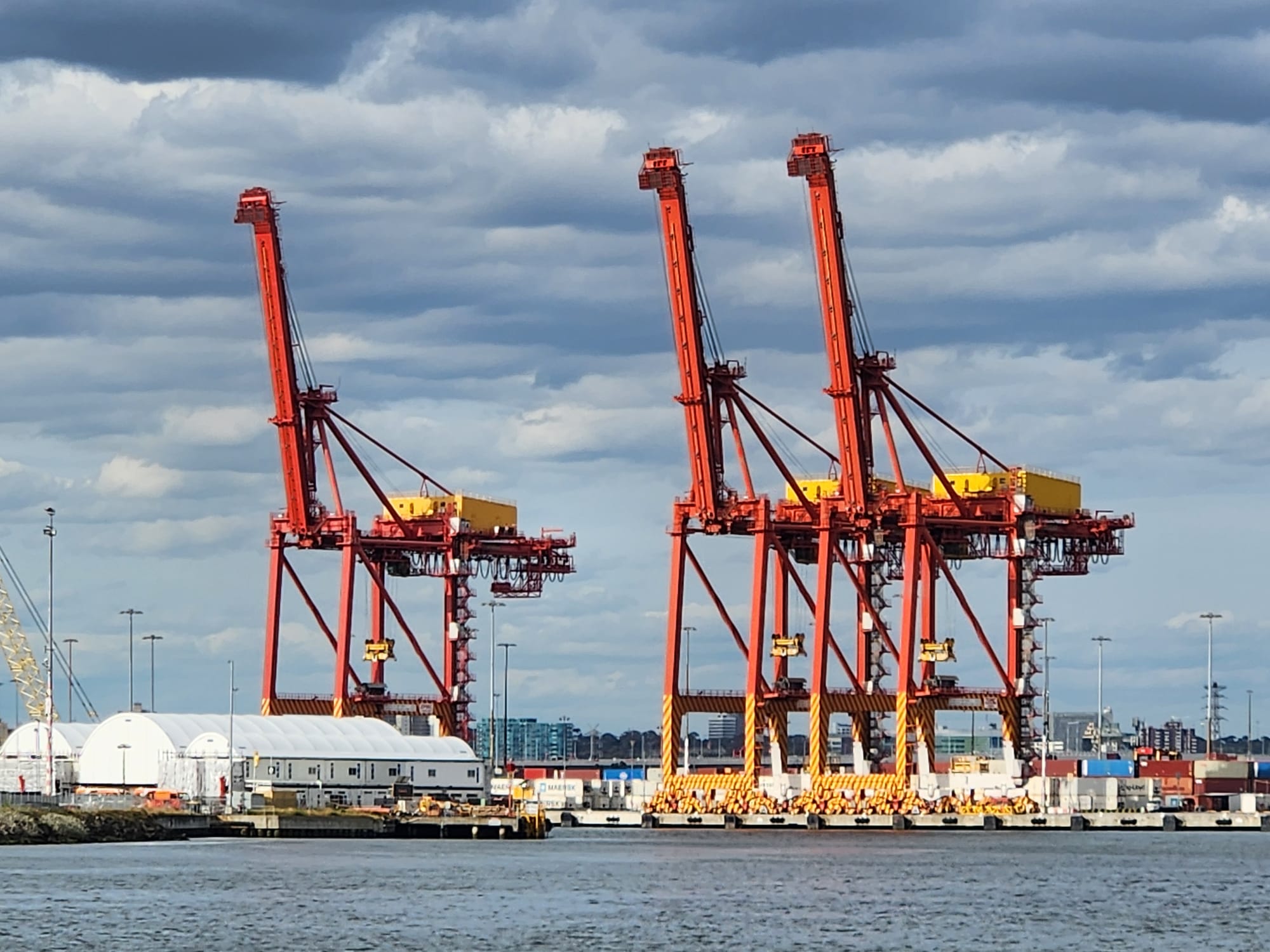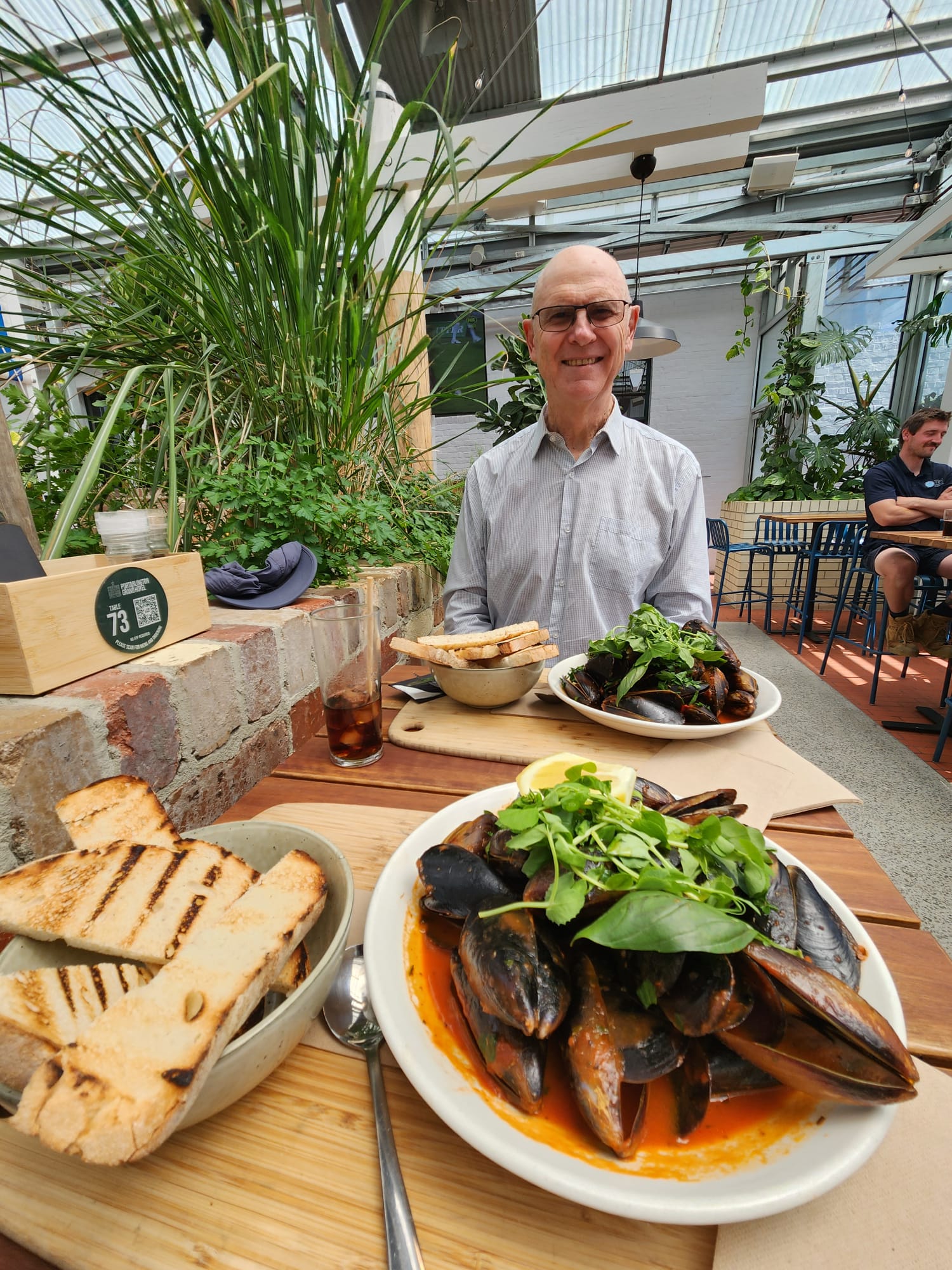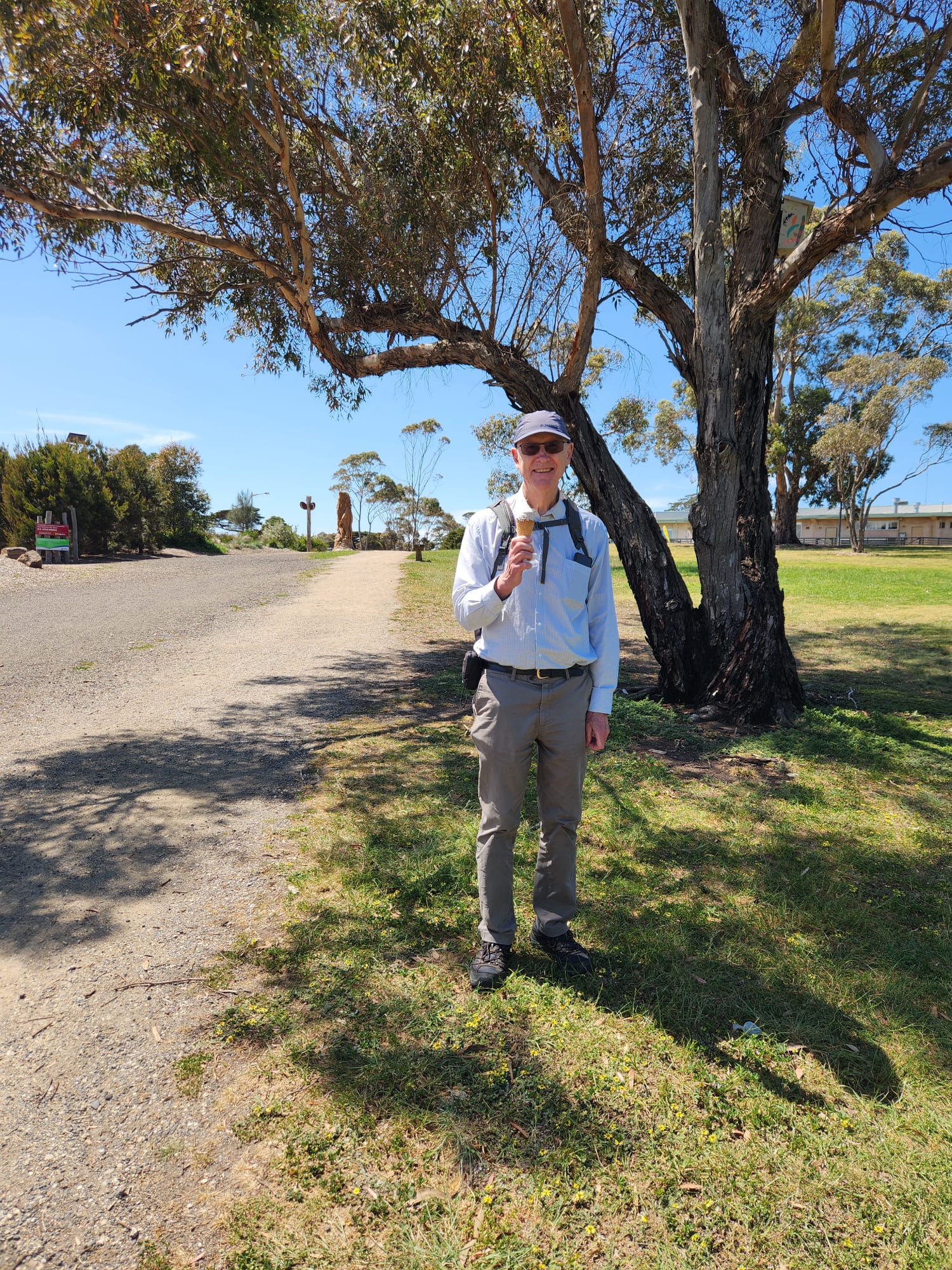Learn English while learning about daily life in Australia, with Rob McCormack
Podcast Number 158 – A Ferry Ride Across Melbourne’s Port Phillip Bay
(This podcast is 13 minutes long.)
Hi,
Melbourne is my home town and is located on the shores of Port Phillip Bay. The bay is quite large and is an important commercial and recreational resource for the city of Melbourne. In this podcast, I would like to tell you a little about the bay and a recent ferry ride which I and my wife took across the bay to a small town called Portarlington.
On a map, you can see that Port Phillip Bay is shaped like a horse head and covers around 1930 square kilometres. It is 58 km long from north to south and 41 km wide from east to west. Its shore line is around 264 kilometres long. It is connected to the ocean by a channel which is only 3.5 km wide. Port Phillip Bay is separated from the ocean waters of Bass Strait by the Mornington Peninsula in the southeast and by the Bellarine Peninsula in the southwest. Portarlington lies on the Bellarine Peninsula. The centre of Melbourne lies on the north side of the bay, and Portarlington lies on the south side of the bay. The ferry ride from the centre of Melbourne to Portarlington is 45 kms long, which takes around 70 minutes.
Port Phillip Bay offers many recreational and sporting opportunities for Melburnians. For example, sailing is very popular and there are 36 yacht clubs around the bay. Fishing is also a popular pastime, either from small boats or from one of the many jetties around the bay. Swimming is of course also popular as there are many beaches around the bay, some with their own surf lifesaving club to help keep people safe (see Podcast 32). Scuba diving is also very popular. In the past, my wife and I have enjoyed owning a small sailing boat which we sailed on the bay. However, nowadays we like to travel on the bay using one of the ferries.
The ferry we took was the 9.30 am Docklands to Portarlington ferry, which is operated by Port Phillip Ferries (see https://www.portphillipferries.com.au/ ). Docklands is the harbour district of Melbourne and is close to the city centre, just a short walk from Southern Cross Railway Station which is one of Melbourne’s main railway stations. The ferry is quite new and travels at a maximum speed of around 50kph for most of the trip.
This trip was a day outing for us. We chose a weekday instead of the weekend, as it would mean fewer people and therefore a more relaxed trip. We caught the bus from our home to Southern Cross Station in the city centre. From there we walked for about 7 minutes and arrived at the Docklands ferry terminal. This area of the city is quite picturesque, with many restaurants and cafes close to the water. We arrived early at the ferry ticket office, which is near the ferry berth. In the front of the ticket office was a nice café serving drinks and snacks. As we had around 30 minutes until we could board the ferry, we ordered two coffees and some raisin toast and sat down to enjoy them. In the meantime, the ferry arrived from Portarlington with commuters who had left Portarlington on the 7.15am ferry to Docklands. We were amazed at how many people got off the ferry. These are people who obviously live in Portarlington or nearby and travel each day to their jobs in the centre of Melbourne. They would all be catching the 5.40pm ferry to get back home that evening. I can’t think of a more relaxing way to get to and from work each day.
With 20 minutes until departure, we boarded the ferry. As expected, it was not crowded at all. We had the choice between sitting inside with a good view through the large windows, or outside and enjoying the fresh air. As the ferry left the harbour, we were able to view the waterfront buildings and the city skyline. I must admit I was surprised how impressive the city looks from the water. We took some great photos as the ferry made its way through the harbour.

The Bolte Bridge over the harbour in Melbourne. Named after one of Victoria’s past Premiers.
Photo by Silvia McCormack.
For the first 2 kilometres or so, the ferry travelled at a modest pace. We passed the large wharves where large container ships and other cargo ships were having their cargo off-loaded or on-loaded. The Port of Melbourne is Australia’s largest port for transport of cargo. It was interesting to see the high number of large cranes and other specialized loading equipment. While I am no expert, it seemed to me that this equipment was quite new and highly automated.
Once we got past all the shipping wharves, the ferry soon increased speed to around 50 kph. It was fascinating to stand on the rear deck and watch the city buildings slowly get smaller and smaller as we sped across the bay to Portarlington. The weather was perfect for such an outing. There were some clouds and the temperature was a comfortable 23 degrees Celsius.
One of the things I like about being on a ferry is watching the boat’s wake and looking at the bird life on the water. As the bay is quite protected from the ocean winds, the trip was quite smooth. On board there was also a kiosk where you could buy drinks and snacks, although on this occasion we were too busy enjoying the view and the fresh air.
With the Melbourne city skyline almost disappearing below the horizon, we finally arrived at our destination at Portarlington and disembarked. The wharf there was quite small, with a jetty and two seawalls giving it some protection from the weather. On the seawalls we could see many people strolling or fishing. We thought, yes, we must walk along both of these seawalls before we leave.
Portarlington is quite small, so we were able to walk around it, check out the shops (including the Portarlington Grand Hotel), take in the views out over the bay and take some more photos. Some of the passengers chose to take a winery tour to vineyards around the area, but we will do that another time.
At around midday we returned to the hotel and ordered two servings of the local specialty – mussels.
They were delicious, although as the waitress had warned us, we did get our hands a little messy getting all the delicious meat out of the shells. That was all part of enjoying the experience. Having left the hotel, we bought ourselves 2 ice cream cones from the ice cream shop next door.
All that remained for us was to walk back down to the jetty and along each of the seawalls. It was great to see the locals out there with their fishing rods and lines trying to catch the local fish. I was impressed with their equipment and seating which they had. Many had small trolleys to carry it all. They were obviously serious about catching fish, while at the same time being comfortable and ready for a few hours fishing. Who doesn’t feel relaxed fishing on a quiet seawall?
At 20 minutes to 4 o’clock, we were able to board the ferry. The return journey to Docklands in the city was very relaxing indeed. We sat on the front deck this time, with the wind gently tugging at our caps as the city skyline slowly came into view. I can’t think of a more relaxing activity than sitting in a comfortable chair on the deck of ferry, enjoying the smell of seawater, watching the waves and feeling like I had no worries in the world. In 70 minutes, we arrived back at Docklands, ready to catch the bus back home.
If you visit Melbourne, I think a ferry trip on Port Phillip Bay is a worthwhile activity.
If you have a question or a comment to make, please leave it in the comments box at the bottom of this page. Or, you can send me an email at rob@slowenglish.info. I would love to hear from you. Tell me where you live, a little bit about yourself and what you think of my Slow English podcast. I will write back to you, in English of course. If you would like to take a short quiz to see if you have understood this podcast, you will also find it on my website. Goodbye until next time.
Rob
Podcast 158 Quiz - Did you understand the podcast?
You can take the quiz as many times as you like.
Vocabulary
automated = when a machine doesn’t need people to work it, it runs by itself
berth = where a boat or ship stops next to a wharf
board = (here) to go onto a boat or ship or plane
caps = (here) a small hat
cargo = the things which a ship carries from one place to another
channel = a narrow place where water can flow
commercial = to do with a business, to do with money
commuters = people who are travelling to or from work
connected = to be joined with
container = (here) a large metal box used to carry cargo on a ship
cranes = large machines which can lift heavy loads (e.g. from a ship to land)
delicious = tastes very good
departure = when you leave (on a train, a boat, bus or plane)
destination = the place where you are going to
disembarked = to get off a ship or plane
equipment = machines to help you do a job
expert = someone who knows a lot about a subject or topic
fascinating = very, very interesting
ferry = a small ship which carries people
harbour district = that area of a town or city next to the harbour (where ships go)
horizon = where the land meets the ocean in the distance
impressive = very, very good
jetties = a walkway built from the land out onto the water
kiosk = a very small shop where you can buy things
located = where something is
messy = not very clean, not well organised
modest = when something is good, but not very good
mussels = a type of shell fish like an oyster, black in colour, grows on rocks
occasion = an event, when something happens
operated = managed, looked after, controlled
opportunities = when you have the chance to do something not normally possible
ordered = to ask for something in a shop (to buy)
outing = a trip to somewhere, normally for fun or pleasure
pastime = a hobby, something you do for fun in your spare time
peninsula = a piece of land which is like an island, but still connected to the mainland
picturesque = is pleasant to look at
recreational = for pleasure, for fun
relaxed = when you are not worried about anything
resource = something you can use
Scuba = a device to allow you to breath underwater
seawalls = a wall of stone or rock built out into the water, where you can walk
separated = kept apart, not together
shores = where the water meets the land
skyline = the shape which city buildings make when seen from a distance
smooth = not rough
snacks = a very small meal, normally eaten between meals
specialized loading equipment = machines which do a very difficult job
strolling = walking slowly
take in the views = to look at the views
terminal = the place where a ferry or bus service finishes or starts
trolleys = a small vehicle on wheels which can help you carry things
tugging = pulling
wake = (here) the white water left behind a ship as it sails along
waterfront = that part of a town or city which is next to the harbour
wharves = where ships stop, found in a harbour
yacht = a boat with sails










